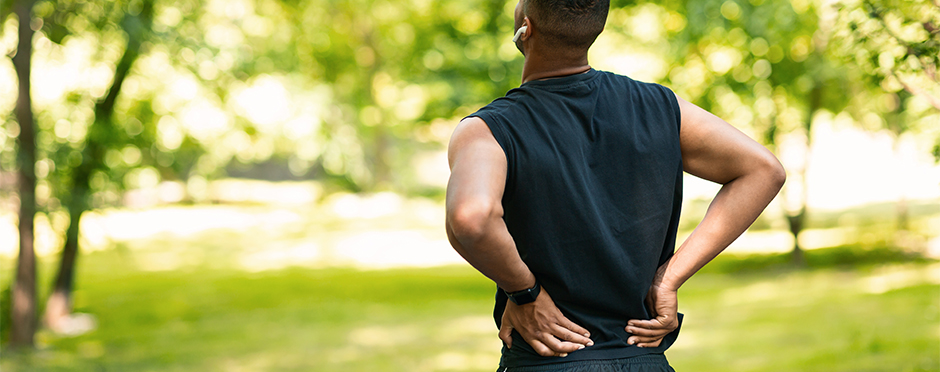
Heat or Ice for Low Back Pain? Why You Should Choose Movement Instead
Leave a CommentSociety has trained us that when we get an injury, or have an ache or pain, we should always choose either heat or ice to try and relieve the discomfort. One of the most common questions that physical therapists get is whether someone should use heat or ice to relieve back pain. The issue with both modalities is that they are passive, and one study found the depth of therapeutic levels of tissue temperature change is one cm. Most tissues that individuals are looking to target with their heat or ice are much deeper, so you are not effectively applying the modality to the depth you want. So, what is the best thing that we can do for our low back pain? Movement!
Why Movement?
Exercise and movement, even light, cause increased blood flow to the body’s musculature and help increase the warmth of the deep muscles. In fact, even going for a brisk walk is as effective as targeted exercises for improvements in lower back pain and deep tissue heating2. The current guidelines based on research also have strong recommendations against bed rest and inactivity when patients have back pain and strong recommendations to encourage movement3.
What type of movement is best?
The first place to start is any beneficial movement. However, when we break it down, if you don’t know what types of exercises to do, the good news is that recent research has demonstrated that a walking program is just as good as specific exercise4. So, with that said, go out for a nice walk if you have some discomfort in your back. Don’t be fearful of movement or change how you move. Your body movements are unique to you.
Other types of exercises can be beneficial for chronic lower back pain (pain that is more than three months old) as well:
- Starting with stabilization exercises without a lot of movement is helpful to set up for success as you get to more functional and higher-level activities. You need to get functional as soon as possible to facilitate a return to your prior level of function
- Many studies demonstrate that yoga therapy is beneficial for the treatment of chronic low back pain5
- General strength training is beneficial to facilitate improvements in low back pain and helps to decrease pain in the immediate area due to the body’s natural pain management system6
What should you do if you have back pain?
Get out and get moving! Motion is lotion and helps your spine get good nutrients in and out of the discs and the joints and helps to warm up the deep muscles of the spine. If you’re having lingering aches and pains, seeing a physical therapist is a great option. Most states and insurance providers allow patients to see a therapist without a prescription from a physician. Most low back pain gets better with physical therapy alone. For more information regarding this, read our post on why you should see a PT first for low back pain.
Do you have pain related to the low back?
Athletico has clinicians who specialize in the treatment of the spine and have undergone training to facilitate better results! Call your local Athletico and schedule an initial evaluation or free assessment with a physical therapist first to get feeling better faster. Ask for a spine specialist!
*Per federal guidelines, beneficiaries of plans such as Medicare, Medicaid, Tricare, VHA and other federally funded plans are not eligible for free assessments.
The Athletico blog is an educational resource written by Athletico employees. Athletico bloggers are licensed professionals who abide by the code of ethics outlined by their respective professional associations. The content published in blog posts represents the opinion of the individual author based on their expertise and experience. The content provided in this blog is for informational purposes only, does not constitute medical advice and should not be relied on for making personal health decisions.
References:
1. Draper DO, Harris ST, Schulthies S, Durrant E, Knight KL, Ricard M. Hot-Pack and 1-MHz Ultrasound Treatments Have an Additive Effect on Muscle Temperature Increase. J Athl Train. 1998;33(1):21-24.
2. Vanti C, Andreatta S, Borghi S, Guccione AA, Pillastrini P, Bertozzi L. The effectiveness of walking versus exercise on pain and function in chronic low back pain: A systematic review and meta-analysis of Randomized Trials. Disability and Rehabilitation. 2017;41(6):622-632. doi:10.1080/09638288.2017.1410730
3. George SZ, Fritz JM, Silfies SP, et al. Interventions for the management of acute and chronic low back pain: Revision 2021. Journal of Orthopaedic & Sports Physical Therapy. 2021;51(11). doi:10.2519/jospt.2021.0304
4. Vanti C, Andreatta S, Borghi S, Guccione AA, Pillastrini P, Bertozzi L. The effectiveness of walking versus exercise on pain and function in chronic low back pain: A systematic review and meta-analysis of Randomized Trials. Disability and Rehabilitation. 2017;41(6):622-632. doi:10.1080/09638288.2017.1410730
5. Posadzki P, Ernst E. Yoga for low back pain: a systematic review of randomized clinical trials. Clin Rheumatol. 2011;30(9):1257- 1262.
6. Vanti C, Andreatta S, Borghi S, Guccione AA, Pillastrini P, Bertozzi L. The effectiveness of walking versus exercise on pain and function in chronic low back pain: A systematic review and meta-analysis of Randomized Trials. Disability and Rehabilitation. 2017;41(6):622-632. doi:10.1080/09638288.2017.1410730
